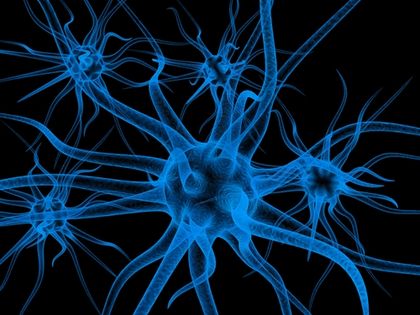Acetylcholine

Acetylcholine is the neurotransmitter produced by neurons referred to as cholinergic neurons. In the peripheral nervous system acetylcholine plays a role in skeletal muscle movement, as well as in the regulation of smooth muscle and cardiac muscle. In the central nervous system acetylcholine is believed to be involved in learning, memory, and mood.
Acetylcholine is synthesized from choline and acetyl coenzyme A through the action of the enzyme choline acetyltransferase and becomes packaged into membrane-bound vesicles . After the arrival of a nerve signal at the termination of an axon, the vesicles fuse with the cell membrane, causing the release of acetylcholine into the synaptic cleft . For the nerve signal to continue, acetylcholine must diffuse to another nearby neuron or muscle cell, where it will bind and activate a receptor protein.
There are two main types of cholinergic receptors, nicotinic and muscarinic. Nicotinic receptors are located at synapses between two neurons and at synapses between neurons and skeletal muscle cells. Upon activation a nicotinic receptor acts as a channel for the movement of ions into and out of the neuron, directly resulting in depolarization of the neuron. Muscarinic receptors, located at the synapses of nerves with smooth or cardiac muscle, trigger a chain of chemical events referred to as signal transduction.

For a cholinergic neuron to receive another impulse, acetylcholine must be released from the receptor to which it has bound. This will only happen if the concentration of acetylcholine in the synaptic cleft is very low. Low synaptic concentrations of acetylcholine can be maintained via a hydrolysis reaction catalyzed by the enzyme acetylcholinesterase. This enzyme hydrolyzes acetylcholine into acetic acid and choline. If acetylcholinesterase activity is inhibited, the synaptic concentration of acetylcholine will remain higher than normal. If this inhibition is irreversible, as in the case of exposure to many nerve gases and some pesticides, sweating, bronchial constriction, convulsions, paralysis, and possibly death can occur. Although irreversible inhibition is dangerous, beneficial effects may be derived from transient (reversible) inhibition. Drugs that inhibit acetylcholinesterase in a reversible manner have been shown to improve memory in some people with Alzheimer's disease.
SEE ALSO Neurotransmitters .
Jennifer L. Powers
Bibliography
Whittaker, V. (1990). "The Contribution of Drugs and Toxins to Understanding of Cholinergic Function." Trends in Physiological Sciences 11:8–13.
Internet Resources
Basic Neuropharmacology. "The Chemistry of the Nervous System." Available from http://www.ptd.neu.edu/neuroanatomy/cyberclass .
King, Michael W. "Biochemistry of Neurotransmitters." Available from http://web.indstate.edu/thcme/mwking .
Comment about this article, ask questions, or add new information about this topic: